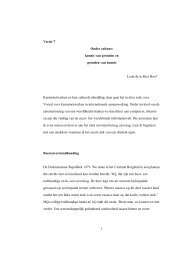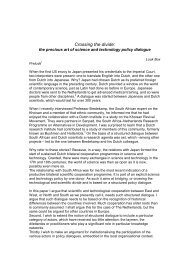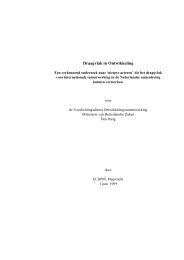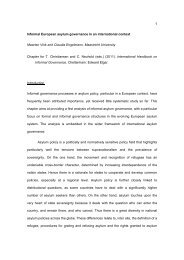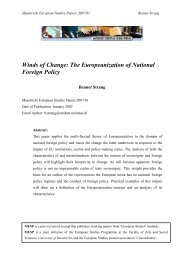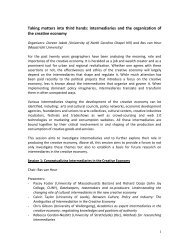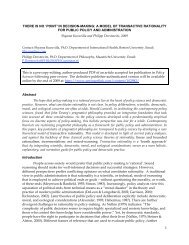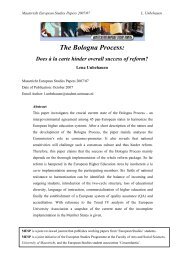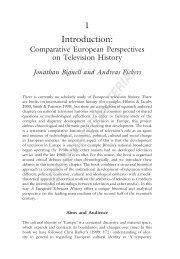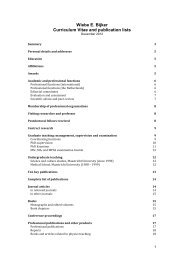the case of the synthetic dye industry, 1857–1914 - Maastricht ...
the case of the synthetic dye industry, 1857–1914 - Maastricht ...
the case of the synthetic dye industry, 1857–1914 - Maastricht ...
You also want an ePaper? Increase the reach of your titles
YUMPU automatically turns print PDFs into web optimized ePapers that Google loves.
182 J.P. Murmann and E. Homburg<br />
In more general terms, two important developments characterized <strong>the</strong> market<br />
penetration <strong>of</strong> syn<strong>the</strong>tic <strong>dye</strong>s after <strong>the</strong> creation <strong>of</strong> <strong>the</strong> first syn<strong>the</strong>tic <strong>dye</strong>: (1)<br />
unremittingly falling prices and (2) <strong>the</strong> continual invention <strong>of</strong> new classes <strong>of</strong><br />
syn<strong>the</strong>tic <strong>dye</strong>s. Ever-lower <strong>dye</strong> prices made it possible for syn<strong>the</strong>tic <strong>dye</strong>s to be<br />
used not only on luxury textiles but also on more common cottons and woolens.<br />
Falling prices were a key force driving <strong>the</strong> gradual replacement <strong>of</strong> natural <strong>dye</strong>s (<strong>of</strong><br />
which <strong>the</strong>re were about thirty different kinds) by cheaper syn<strong>the</strong>tic equivalents.<br />
The invention <strong>of</strong> new classes <strong>of</strong> syn<strong>the</strong>tic <strong>dye</strong>s was even more important in this<br />
substitution process. The early aniline <strong>dye</strong>s replaced only a few <strong>of</strong> <strong>the</strong> natural<br />
<strong>dye</strong>s. Later innovations led to <strong>the</strong> gradual replacement <strong>of</strong> <strong>the</strong> o<strong>the</strong>r natural <strong>dye</strong>s.<br />
Every single major breakthrough led to new waves <strong>of</strong> entry in <strong>the</strong> syn<strong>the</strong>tic <strong>dye</strong><br />
business.<br />
The second entry wave, which occurred between 1871–1873, provides a good<br />
example <strong>of</strong> <strong>the</strong> consequences <strong>of</strong> such a major breakthrough. The development <strong>of</strong><br />
syn<strong>the</strong>tic alizarin in 1868 opened up a huge market that was formerly served by<br />
natural <strong>dye</strong> makers. Many firms sought to pr<strong>of</strong>it from this fast-growing market<br />
and entered <strong>the</strong> <strong>industry</strong>, leading to ano<strong>the</strong>r significant jump in <strong>the</strong> number <strong>of</strong><br />
firms in <strong>the</strong> <strong>industry</strong>. We found support for <strong>the</strong> proposition that firms entered<br />
<strong>the</strong> <strong>industry</strong> to take advantage <strong>of</strong> <strong>the</strong> alizarin market by comparing <strong>the</strong> product<br />
portfolios <strong>of</strong> all syn<strong>the</strong>tic <strong>dye</strong> producers on January 1, 1868, with <strong>the</strong> product<br />
portfolios <strong>of</strong> new producers in <strong>the</strong>ir entry year for <strong>the</strong> period from 1868 to 1876.<br />
There were 52 producers <strong>of</strong> aniline <strong>dye</strong>s on January 1, 1868, 4% <strong>of</strong> which also<br />
made azo <strong>dye</strong>s, 19% made natural <strong>dye</strong>s, 17% fine chemicals, 8% inorganic basic<br />
chemicals, 13% organic basic chemicals, and 33% intermediates. None <strong>of</strong> <strong>the</strong>se<br />
firms made alizarin (see Table 1). In 1869 a few existing companies (Hoechst,<br />
BASF and Perkin & Sons) started to make alizarin. But soon new companies<br />
were founded that started as specialized alizarin producers. In 1870, 2 <strong>of</strong> <strong>the</strong> 7<br />
entrants (28.6%) made alizarin and 5 <strong>of</strong> <strong>the</strong> 7 entrants (71%) made aniline <strong>dye</strong>s.<br />
In 1871, 20% <strong>of</strong> 10 entrants made alizarin, in 1872 75% <strong>of</strong> <strong>the</strong> 4 entrants did,<br />
and from 1873 to 1876 between 33% and 66% <strong>of</strong> <strong>the</strong> new entrants were founded<br />
as alizarin producers (Table 1). 7<br />
The third entry wave, 1878–1885, was stimulated by <strong>the</strong> invention <strong>of</strong> a new<br />
class <strong>of</strong> azo <strong>dye</strong>s that were based on <strong>the</strong> so-called “coupling” reaction. This<br />
coupling reaction gave rise to seemingly endless possibilities for new <strong>dye</strong>s (van<br />
den Belt and Rip, 1987, pp. 148–149). By <strong>the</strong> First World War, <strong>the</strong> largest number<br />
<strong>of</strong> <strong>dye</strong>s sold in <strong>the</strong> market fell into <strong>the</strong> class <strong>of</strong> azo <strong>dye</strong>s.<br />
The fourth entry wave, 1904–1913, probably was a result <strong>of</strong> <strong>the</strong> general<br />
economic uplift in <strong>the</strong> years just before <strong>the</strong> First World War, as well as <strong>the</strong><br />
development <strong>of</strong> a new class <strong>of</strong> <strong>dye</strong>s (<strong>the</strong> so-called sulfur <strong>dye</strong>s), <strong>the</strong> growing specialization<br />
among <strong>the</strong> <strong>dye</strong> firms, and <strong>the</strong> emergence <strong>of</strong> <strong>dye</strong> firms in some smaller<br />
countries. Sulfur <strong>dye</strong>s were cheap and easy to make and <strong>the</strong>refore facilitated<br />
<strong>the</strong> entry <strong>of</strong> new firms into <strong>the</strong> syn<strong>the</strong>tic <strong>dye</strong> <strong>industry</strong> (as, for example, in <strong>the</strong><br />
<strong>case</strong>s <strong>of</strong> Th. Handschin & Co. and James Robinson & Co., Ltd.). Fur<strong>the</strong>rmore,<br />
7 At first glance <strong>the</strong> numbers in Table 1 seem somewhat different from those in Figures 1 and 2.<br />
But this is not so. Figures 1 and 2 present <strong>the</strong> 3-year moving averages <strong>of</strong> <strong>the</strong> data in Table 1.



